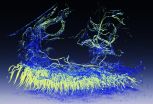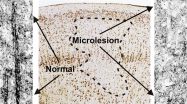(Press-News.org) Fireflies used rapid light flashes to communicate. This "bioluminescence" is an intriguing phenomenon that has many potential applications, from drug testing and monitoring water contamination, and even lighting up streets using glow-in-dark trees and plants. Fireflies emit light when a compound called luciferin breaks down. We know that this reaction needs oxygen, but what we don't know is how fireflies actually supply oxygen to their light-emitting cells. Using state-of-the-art imaging techniques, scientists from Switzerland and Taiwan have determined how fireflies control oxygen distribution to light up their cells. The work is published in Physical Review Letters.
The firefly's light-producing organ is called the "lantern", and it is located in the insect's abdomen. It looks like a series of tubes progressing into smaller ones and so one, like a tree's branches growing into twigs. The function of these tubes, called, is to supply oxygen to the cells of the lantern, which contain luciferase and can produce light. However, the complexity of the firefly's lantern has made it difficult to study this mechanism in depth, and reproduce it for technological applications.
Giorgio Margaritondo at EPFL, Yeukuang Hwu at the Academia Sinica and their colleagues at the National Tsing Hua University in Taiwan have successfully used two sophisticated imaging techniques to overcome the complexity of the firefly lantern and map out how oxygen is supplied to light-emitting cells. The techniques are called synchrotron phase contrast microtomography and transmission x-ray microscopy. They can scan down to the level of a single cell, even allowing researchers to look inside it.
By applying these techniques on live fireflies, the scientists were able to see the entire structure of the lantern for the first time, and to also make quantitative evaluations of oxygen distribution.
The imaging showed that the firefly diverts oxygen from other cellular functions and puts it into the reaction that breaks up luciferin. Specifically, the researchers found that oxygen consumption in the cell decreased, slowing down energy production. At the same time, oxygen supply switched to light-emission.
The study is the first to ever show the firefly's lantern in such detail, while also providing clear evidence that it is optimized for light emission thanks to the state-of-the-art techniques used by the scientists. But Margaritondo points out another innovation: "The techniques we used have an advantage over, say, conventional x-ray techniques, which cannot easily distinguish between soft tissues. By using an approach based on changes in light intensity (phase-contrast) as opposed to light absorption (x-rays), we were able to achieve high-resolution imaging of the delicate firefly lantern."
INFORMATION:
This work represents a collaboration of EPFL with the following institutes in Taiwan: Academia Sinica, the National Tsing Hua University, the Endemic Species Research Institute, the National Taiwan University, and the National Cheng Kung University.
Reference
Tsai Y-L, Li C-W, Hong T-M, Ho J-Z, Yang E-C, Wu W-Y, Margaritondo G, Hsu S-T, Ong EBL, Hwu Y. Firefly Light Flashing: Oxygen Supply Mechanism. Physical Review Letters 17 December 2014.
This news release is available in French. This news release is available in French.
People with a severe mental disorder who commit a crime and who are incarcerated have different characteristics compared to people who are hospitalized after committing an offence. These are the findings of a study by researchers at the Institut universitaire en santé mentale de Montréal (IUSMM) and the Institut Philippe-Pinel de Montréal (IPPM), affiliated with the University of Montreal.
"We found a clear difference between people with a mental illness who are ...
Cancer Research UK scientists have shown that loss of a gene called PTEN triggers some cases of an aggressive form of ovarian cancer, called high-grade serous ovarian cancer, according to a study published in Genome Biology today (Wednesday)*.
In a revolutionary approach the researchers from the Cancer Research UK Cambridge Institute made the discovery by combining images from cancer samples with genetic data. They proved conclusively that loss of PTEN was commonly found only in the cancerous cells and not the 'normal' cells that help make up the tumour mass.
PTEN ...
Using an innovative technique combining genetic analysis and mathematical modeling with some basic sleuthing, researchers have identified previously undescribed microlesions in brain tissue from epileptic patients. The millimeter-sized abnormalities may explain why areas of the brain that appear normal can produce severe seizures in many children and adults with epilepsy.
The findings, by researchers at the University of Illinois at Chicago College of Medicine, Wayne State University and Montana State University, are reported in the journal Brain.
Epilepsy affects about ...
The deep sea is becoming a collecting ground for plastic waste, according to research led by scientists from Plymouth University and Natural History Museum.
The new study, published today in Royal Society Open Science, reveals around four billion microscopic plastic fibres could be littering each square kilometre of deep sea sediment around the world.
Marine plastic debris is a global problem, affecting wildlife, tourism and shipping. Yet monitoring over the past decades has not seen its concentration increase at the sea surface or along shorelines, despite experts ...
New research suggests our jawed ancestors weren't responsible for the demise of their jawless cousins as had been assumed. Instead Dr Robert Sansom from The University of Manchester believes rising sea levels are more likely to blame. His research has been published in the journal Proceedings of the Royal Society B.
He says: "When our jawed vertebrate ancestors overtook their jawless relatives 400 million years ago, it seems that it might not have been through direct competition but instead the inability of our jawless cousins to adapt to changing environmental conditions."
In ...
In another demonstration that brain-computer interface technology has the potential to improve the function and quality of life of those unable to use their own arms, a woman with quadriplegia shaped the almost human hand of a robot arm with just her thoughts to pick up big and small boxes, a ball, an oddly shaped rock, and fat and skinny tubes.
The findings by researchers at the University of Pittsburgh School of Medicine, published online today in the Journal of Neural Engineering, describe, for the first time, 10-degree brain control of a prosthetic device in which ...
NEW YORK (16 December 2014) -- The Population Council published new research in the November issue of the journal Contraception demonstrating that an investigational one-year contraceptive vaginal ring containing Nestorone® and ethinyl estradiol was found to be highly acceptable among women enrolled in a Phase 3 clinical trial. Because the perspectives of women are critical for defining acceptability, researchers developed a theoretical model based on women's actual experiences with this contraceptive vaginal ring, and assessed their overall satisfaction and adherence ...
American states got tough on impaired driving in the 1980s and 1990s, but restrictions have flat lined.
A new study looks at associations between levels and types of law-enforcement efforts and prevalence of drinking and driving.
The number of traffic stops and DUI arrests per capita had the most consistent and significant associations.
From 1982 to 1997, American states got tough on impaired driving. Policies favored adopting lower blood alcohol concentration (BAC) limits for driving, administrative license revocation (ALR), and increased sanctions for those convicted ...
Alcohol outlets tend to be concentrated in lower-income areas. Given that alcohol-related problems such as trauma, chronic disease, and suicide occur more frequently in areas with a greater density of alcohol outlets, lower-income populations are exposed to increased risk. This study examines the distribution of rural outlets in the state of Victoria, Australia, finding towns had more outlets of all types where the average income was lower and where the average income in adjacent towns was higher, and that this was consistent with retail market dynamics.
Results will ...
The heaviest drinking and steepest trajectory of increasing alcohol problems are typically observed during the mid-teens to mid-20s. One common and adverse consequence is the alcohol-related blackout (ARB), which is reported by up to 50 percent of drinkers. However, there are few studies of the trajectories of ARBs over time during mid-adolescence. A new study identifying different trajectories of ARBs between ages 15 and 19, along with predictors of those patterns, has found that certain adolescents with particular characteristics are more likely to drink to the point ...



